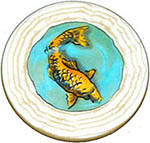
In the game of Seikatsu - a word that means "life" in Japanese - players tend a shared garden between each of their pagodas, and compete to have the most breathtaking view of the finished garden.
Take turns drawing and playing Garden tiles that feature both a bird and a flower to create flocks of birds and rows of flowers, as seen from your pagoda. Who has the best view of the garden? It's all a matter of perspective!

Components
- 1 Garden board
- 32 garden tiles
- 1 Cloth Bag
- 3 Scoring Pawns
- 4 Koi Pond Tiles
Setup
1 Lay out the Garden board in the center of the play area, and rotate it so that each player is directly facing one of the Pagodas on the board. The pagoda you are facing determines your player color. In a 2-player game use only the pink and blue pagodas.
3 Put all Garden tiles in the Cloth bag and mix them well.
4 In a 2-player game, draw 2 tiles at random from the Cloth bag and place them on the two spaces adjacent to the koi pond at the center of the Garden board that have flowers.
In a 3-player game, draw 3 tiles from the Cloth bag and place them on the three spaces adjacent to the koi pond at the center of the Garden board that have flowers.
5 Add the Koi Pond tiles to the Cloth bag and mix well.
6 Each player draws 2 tiles from the cloth bag, facedown, into their hand.
7 The wisest player takes the Cloth bag and goes first.

Game Play
The game is played in turns, beginning with the first player and going clockwise, until the entire Garden board has been filled with tiles. If you're holding the Cloth bag, it's your turn.
In a 2-player game each player will have 17 turns. In a 3-player game, each player will have 11 turns.
On your turn, you carry out three simple steps, in order:
- Play a Tile
- Score Matching Birds
- Draw a New Tile
1. Play a Tile
On your turn, play any tile from your hand. Follow these two rules when playing the tile:
- Play the tile on an empty space.
- Play the tile adjacent to another tile already on the Garden board.
Note: The center space of the Garden board is not considered an empty space. You may not play a Garden or Koi tile in the center space.
2. Score Matching Birds
When a bird on the tile you played matches (i.e., is identical to) another bird on an adjacent Garden tile, it forms a Flock of Birds. Score 1 point for the bird on the tile you just played, and 1 point for each matching bird on an adjacent tile.
If the bird on the Garden tile does not match any adjacent birds, you do not score any points. Track your score by moving your Scoring pawn along the Score track.
Bird Scoring Example
 A Flock of identical birds score immediately |
Koi Pond tiles count as a bird of your choice but only on the turn they are played. You'll score points for making a Flock on the turn you place the Koi Pond tile.
On all subsequent turns taken by you and your opponents, the Koi Pond tile does not count as a bird and will not be scored as part of a Flock of birds.
Bird Scoring Example
Koi Pond Counts as a Bird of One Color
The next time a matching bird is laid down,
the Koi Pond tile does not score.
3. Draw a New Tide

Draw a new tile from the Cloth bag, if any remain, then pass the bag clockwise to the next player. On your final two turns, no tiles will be left in the bag.
Garden Tides
There are two duplicates of each of the 16 different Garden tiles. Each Garden tile features a bird and a flower.
There are 4 types of flowers: Primrose (purple), Plumeria (pink), Tulip (orange), and Bluebell (blue); and there are 4 types of birds: Scarlet Tanager (red), Japanese Waxwing (grey), Japanese White Eye (green), and Japanese Paradise Flycatcher (dark blue). Each of the flowers and birds appear on exactly 8 Garden tiles.
Note: Tiles in your hand should be kept hidden from all other players until played.
Koi Pond Tiles

The Koi Pond tile is a special "wild" tile that features a koi fish instead of a bird/flower pair. When you play a Koi Pond tile, it acts as a bird of your choice this turn, and scores as part of a Flock of birds.
Once your turn is over, the Koi Pond tile no longer counts as a bird. At the end of the game, each Koi Pond tile acts as a flower of your choice for flower scoring. A Koi Pond tile may be scored as a different flower by different players.
Example: One player may score the tile as an orange Tulip, the second player scores the same tile as a pink Plumeria, and the third player scores it as a purple Primrose.
End of the Game
When each player has played the last tile from their hand, the Garden board should be completely filled and the game is over.
To determine the winner, each player will score for the rows of flowers they have planted, and will add those points to the points earned for Flocks of birds throughout the game.
Scoring Flowers
To score flowers, look down the rows of tiles on the Garden board, from the perspective of your pagoda.
In each row, identify the largest flower set, which is the largest group of a single type of flower in that row. The flowers in the set do not need to be adjacent to one another in the row. You score only the largest flower set in each row.
If there is a tie for largest set in a row, simply score one of the tied sets. Each Koi Pond tile acts as a flower of your choice during flower scoring. A Koi Pond tile may be scored as a different flower by different players.
Sets of flowers score as follows:
- 1 Flower - 1 pt
- 2 Flowers - 3pts
- 3 Flowers - 6pts
- 4 Flowers - 10pts
- 5 Flowers - 15pts
- 6 Flowers - 21 pts
It's easiest to score flowers one player at a time, starting with the player in last place and proceeding in reverse order. If a player's score exceeds 50 points, continue along the Score Track as normal and add 50 to your final score.

After flower scores have been determined, the player with the most total points is the winner! In the case of a tie, the tied player who was last in the turn order wins.
Tournament Mode
During setup instead of drawing 2 Garden tiles at random from the Cloth bag, distribute the 4 Koi Pond tiles, face-up to each player.
In a 2-player game, give each player 2 of these Koi Pond tiles. In a 3-player game, give each player 1 Koi Pond tile and then give the 1 remaining Koi Pond tile to the player last in turn order (i.e., seated to the right of the first player). In a 4-player game, give each player 1 Koi Pond tile.
Continue Reading


